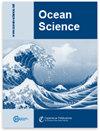通过精细海温同化改善区域海洋模式的海温
IF 3.3
3区 地球科学
Q2 METEOROLOGY & ATMOSPHERIC SCIENCES
引用次数: 2
摘要
摘要红外(IR)和被动微波(PMW)卫星海表温度(SST)反演对同化成高分辨率区域海洋预报模式具有重要价值。尽管如此,仍有一些与这些海温有关的问题需要解决,以实现更好的海洋预报。首先,卫星海表温度产品存在偏差。因此,吸收来自不同提供者的海温可能导致海洋模型接收到不一致的信息。其次,虽然PMW SSTs在多云条件下对约束模型有价值,但这些检索的空间分辨率相当粗糙。将PMW海温同化到高分辨率海洋模型中,将使模拟海温在空间上平滑,从而去除更精细的海温结构。在这项研究中,我们实现了一种偏差校正方案,在同化之前对卫星海温进行校正。我们还在区域海洋模拟系统(ROMS)的四维变分同化算法中引入了一种特殊的观测算子——超模算子。这个超级模型算子处理粗观测和精细模型之间的分辨率不匹配。我们使用覆盖挪威大陆架海和大陆架断裂的ROMS设置测试了偏差校正方案和超级模型算子。结果表明,采用偏差校正方案后,模型海表温度的验证统计量得到了改善。当我们将PMW SSTs与IR SSTs结合使用时,我们还发现验证统计数据有所改善。然而,我们的supermod操作符必须被激活,以避免在小于PMW海温足迹的两倍的空间尺度上平滑模拟海温结构。偏差校正方案和超模算子都易于应用,而且超模算子可以很容易地适应其他观测变量。本文章由计算机程序翻译,如有差异,请以英文原文为准。
Improving sea surface temperature in a regional ocean model through refined sea surface temperature assimilation
Abstract. Infrared (IR) and passive microwave (PMW) satellite sea surface temperature (SST) retrievals are valuable to assimilate into high-resolution regional ocean forecast models. Still, there are issues related to these SSTs that need to be addressed to achieve improved ocean forecasts. Firstly, satellite SST products tend to be biased. Assimilating SSTs from different providers can thus cause the ocean model to receive inconsistent information. Secondly, while PMW SSTs are valuable for constraining models during cloudy conditions, the spatial resolution of these retrievals is rather coarse. Assimilating PMW SSTs into high-resolution ocean models will spatially smooth the modeled SST and consequently remove finer SST structures. In this study, we implement a bias correction scheme that corrects satellite SSTs before assimilation. We also introduce a special observation operator, called the supermod operator, into the Regional Ocean Modeling System (ROMS) four-dimensional variational data assimilation algorithm. This supermod operator handles the resolution mismatch between the coarse observations and the finer model. We test the bias correction scheme and the supermod operator using a setup of ROMS covering the shelf seas and shelf break off Norway. The results show that the validation statistics in the modeled SST improve if we apply the bias correction scheme. We also find improvements in the validation statistics when we assimilate PMW SSTs in conjunction with the IR SSTs. However, our supermod operator must be activated to avoid smoothing the modeled SST structures on spatial scales smaller than twice the PMW SST footprint. Both the bias correction scheme and the supermod operator are easy to apply, and the supermod operator can easily be adapted for other observation variables.
求助全文
通过发布文献求助,成功后即可免费获取论文全文。
去求助
来源期刊

Ocean Science
地学-海洋学
CiteScore
5.90
自引率
6.20%
发文量
78
审稿时长
6-12 weeks
期刊介绍:
Ocean Science (OS) is a not-for-profit international open-access scientific journal dedicated to the publication and discussion of research articles, short communications, and review papers on all aspects of ocean science: experimental, theoretical, and laboratory. The primary objective is to publish a very high-quality scientific journal with free Internet-based access for researchers and other interested people throughout the world.
Electronic submission of articles is used to keep publication costs to a minimum. The costs will be covered by a moderate per-page charge paid by the authors. The peer-review process also makes use of the Internet. It includes an 8-week online discussion period with the original submitted manuscript and all comments. If accepted, the final revised paper will be published online.
Ocean Science covers the following fields: ocean physics (i.e. ocean structure, circulation, tides, and internal waves); ocean chemistry; biological oceanography; air–sea interactions; ocean models – physical, chemical, biological, and biochemical; coastal and shelf edge processes; paleooceanography.
 求助内容:
求助内容: 应助结果提醒方式:
应助结果提醒方式:


